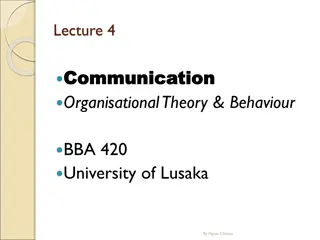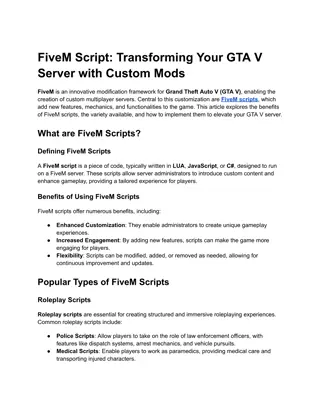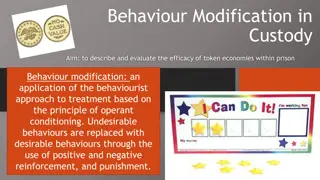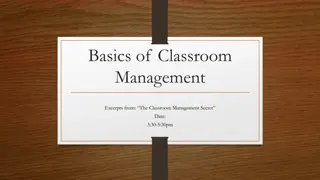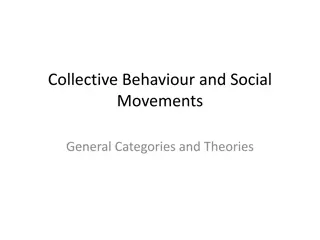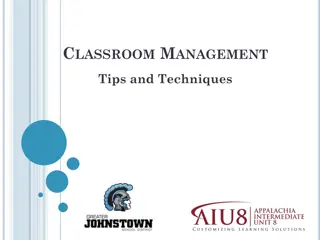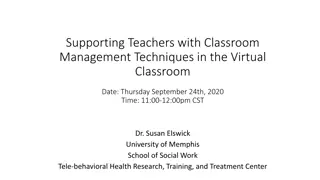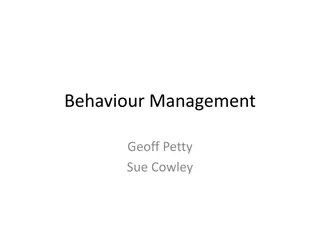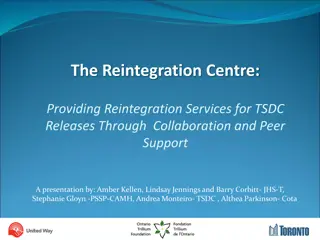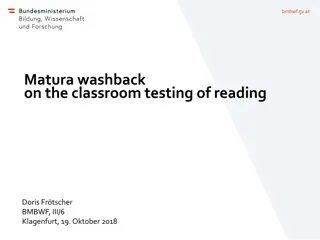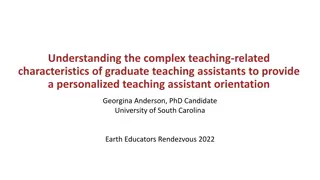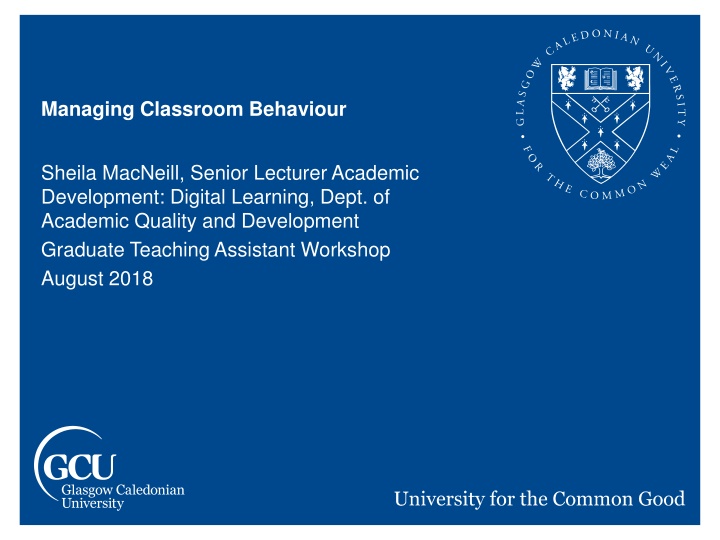
Managing Classroom Behavior: Insights and Strategies
Explore the concept of uncivil behavior in the university classroom and learn effective strategies for managing it. Delve into causes, impact, and solutions while discussing real-life examples and student perceptions. Gain valuable insights to foster a positive learning environment.
Download Presentation

Please find below an Image/Link to download the presentation.
The content on the website is provided AS IS for your information and personal use only. It may not be sold, licensed, or shared on other websites without obtaining consent from the author. If you encounter any issues during the download, it is possible that the publisher has removed the file from their server.
You are allowed to download the files provided on this website for personal or commercial use, subject to the condition that they are used lawfully. All files are the property of their respective owners.
The content on the website is provided AS IS for your information and personal use only. It may not be sold, licensed, or shared on other websites without obtaining consent from the author.
E N D
Presentation Transcript
Managing Classroom Behaviour Sheila MacNeill, Senior Lecturer Academic Development: Digital Learning, Dept. of Academic Quality and Development Graduate Teaching Assistant Workshop August 2018
Aims By the end of this session you should be able to: Reflect on the concept of uncivil behaviour Identify potential causes of such behaviour Consider some strategies for managing it Discuss solutions with experienced GCU teachers page 2
The problem of definition What is bad behaviour? page 3
The concept of classroom incivility slippery concept (Bjorklund and Rehling, 2010) Un/ incivil behaviour is not in accordance with the unity of the classroom community or is contrary to the well-being of the classroom community, including behaviours that distract the instructor or other students , disrupt classroom learning, discourage the instructor from teaching, discourage other students from participating , derail the instructor s goals for the period etc. (ibid, p. 16) page 4
What is incivil behaviour to you? Group activity 1 1. Discuss the following questions in groups: What kinds of incivil behaviour have you witnessed in the university classroom? Give examples. What was the impact of that behaviour? What was your role in the situation? How did you feel in that situation? 2. Write your answers using these three headings: Examples Impact Feelings You have 10 minutes for this activity Appoint a person to feed back your results. page 5
What classroom behaviour do you think is the most uncivil www.menti.com and use the code 81 07 41 page 6 6
Ranking incivility in the university classroom: Student perceptions (Bjorklund and Rehling, 2010) Survey of 3,616 students at US university in Midwest Conversing loudly with others Text messaging Eating and drinking Doing work for other classes Allowing a phone to ring Continuing to talk after being asked to stop Coming to class under influence of alcohol or drugs Arriving late and / or leave early page 7
What do staff think? How common is disruptive behaviour? Some statistics (Dordoy et al, 2008) Staff survey (Gannon-Leary, in Dordoy et al, 2008) Is disruptive behaviour more prevalent now that it had been previously? 59% agreed 16% disagreed page 8
What might be the reasons for incivil behaviour? Group activity 2 Discuss the question in your group Write the results on the flipchart Rank the reasons from what might be the most common to what might be the least common? You have 10 minutes to complete the task page 9
Reasons? Some results from research What was the main reason? Students find classes boring 80% of students; 61% of staff Lecturers who make it apparent they don t want to be there and who have made no effort in the preparation of the lecture. Why should students bother if the lecturer doesn t? (Students) If you are not giving them quality teaching then we all get bored if you are giving them what they want and keeping them thinking about it, not being too easy or too hard. (Staff) page 10
Group dynamic: some students believed that they could enhance their status through bad behaviour 62% of staff ; 59% of students Certain courses seem particularly bad. A whole cohort can develop a sense of group identity and feel that the usual rules don t apply; those behaving badly may be trying to fit in and have a personality in front of their peers . (Staff) page 11 11
What can you do? When I was an undergraduate, there was a group of students who would talk constantly during lectures. They would sit near the front and, although not particularly loud, it was very distracting. They would do this in every class. One day, one of our lecturers got fed up of this constant, low level chatter and said something about respect and being old enough to know when to be quiet then he just walked out. The lecture had barely started. He just left. While I agreed with him in principle, I was annoyed that he didn't ask the group to leave and instead, deprived the entire class of lecture. That group didn't stop their disruptive behaviour in the end so it was a waste of everyone's time. page 12
Some basic coping strategies Engage students in a relaxed class atmosphere Establish a confident leadership style Establish the ground rules at the start Don t ignore disruption But don t over-react Don t be confrontational Don t argue with persistent critics in front of the class Don t suffer alone Think in advance about how you would react to a range of hypothetical situations page 13
Wait for silence. Stop talking in mid-sentence if required Try speaking more quietly Make direct eye contact with students Move away from the front and stand next to disruptive group Use remote mouse and microphone Don t be afraid to ask students to move forward from the back of a large lecture theatre Organise activities so as to be able to split up potential trouble makers Learn student names and ask individual questions Cover essential information at beginning and end of class Defuse the situation by dealing with conflict outside class Do not turn a crisis into a drama page 14 14
A 10 step approach 1. 2. 3. 4. 5. 6. 7. 8. 9. 10. Be prepared to change what you do Don t take it personally. Stay calm Allow the student to save face Be polite and don t get into an argument Listen to the students and try to understand their reasons Decide what you are going to do and explain it to your students Follow through and be consistent Never threaten action you are not prepared to carry out Ask yourself some difficult questions page 15
References Bjorklund, W. and Rehling, D.L. (2010) Student Perceptions of Classroom Incivility, College Teaching, 58:15-18 Dordoy, A, Gannon-Leary, P, Morning, D and Crane, R. (2008) Disruptive student behaviour, Paper 50, Northumbria University https://www.northumbria.ac.uk/static/5007/arpdf/academy/redguide50 Race, P. and Pickford, R. (2007) Making Teaching Work: Teaching Smarter in Post- Compulsory Education, London: Sage Stanford University, Tomorrow s Professor Postings, Dealing with Disruptive Student Behaviour https://tomprof.stanford.edu/posting/1353 page 16


